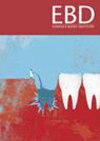纤维还是立面?纤维增强复合材料在II级修复中真的经得起考验吗?
IF 2.3
Q3 Dentistry
引用次数: 0
摘要
Mohamed M H, Abouauf E A, Mosallam R s。ⅱ类MOD纤维增强树脂复合材料修复体的临床性能:18个月随机对照临床试验。BMC口腔健康2025;25: 159。https://doi.org/10.1186/s12903 - 025 - 05521 - 5。设计:进行了一项为期18个月的双盲随机对照试验,比较纤维增强树脂复合材料与传统纳米混合树脂复合材料在修复II类MOD腔中的临床性能。参与者被分配到三组中的一组:第一组使用短玻璃纤维增强树脂复合材料,第二组使用聚乙烯纤维增强树脂复合材料,第三组使用常规纳米混合树脂复合材料。一名首席研究员对所有参与者进行了修复程序。病例选择:研究的参与者来自埃及开罗大学的教育诊所。共纳入45名参与者,平均年龄为32.3±7.3岁。所有参与者都有II级MOD龋齿病变,ICDAS评分为3,4或5。此外,仅包括口腔卫生良好、牙周健康、咬合正常的患者。该研究排除了怀孕患者,以及那些有全身性疾病或有不良习惯的患者。对所用材料过敏、继发性龋齿或敏感性测试反应延迟的患者也被排除在外。数据分析:结果由两名审查员在基线和以下时间间隔进行评估:3、6、12、18个月,使用修改的USPHS标准。评估的主要结果是边缘适应,其次是大体骨折、边缘变色、颜色匹配和复发性龋齿。临床意义是根据相对风险来确定的。卡方检验组间比较P≤0.016,科克伦Q检验组内比较P≤0.005,均采用Bonferroni校正。该研究的置信度为95%,统计效力为80%。结果:该研究的保留率为97.7%,除1例患者外,其余患者均成功完成18个月的随访期。颜色匹配是两组之间唯一有统计学差异的结果,短玻璃纤维增强修复体显示出一些颜色差异。其他结果如边缘适应、边缘变色、复发性龋齿和大体骨折在两组间无显著差异。年龄、性别、牙齿分布差异无统计学意义。结论:在18个月的时间内,纤维增强树脂复合材料修复体的临床性能与纳米复合材料修复体相似且相当。短玻璃纤维增强修复体在颜色匹配上表现出变化,表明应该仔细考虑美学结果。本文章由计算机程序翻译,如有差异,请以英文原文为准。
Fibre or facade? Do fibre reinforced composites really hold up in Class II restorations?
Mohamed M H, Abouauf E A, Mosallam R S. Clinical performance of class II MOD fiber reinforced resin composite restorations: an 18-month randomized controlled clinical trial. BMC Oral Health 2025;25: 159. https://doi.org/10.1186/s12903-025-05521-5 . A double blinded 18-month randomised controlled trial was carried out to compare the clinical performance of fibre reinforced resin composites compared to conventional nanohybrid resin composites in restoring Class II MOD cavities. Participants were allocated to one of three groups: Group 1 with short glass fibre reinforced resin composite, Group 2 with polyethylene fibre reinforced resin composite and Group 3 with conventional nanohybrid resin composite. A principal investigator carried out the restorative procedures for all participants. Participants in the study were enrolled from the educational clinic in Cairo University, Egypt. A total of 45 participants with a mean age of 32.3 ± 7.3 years were included. All participants had class II MOD carious lesions in vital posterior teeth with ICDAS scores of 3,4 or 5. Additionally only those with good oral hygiene, a healthy periodontal status and normal occlusion were included. The study excluded pregnant patients, as well as those with systemic disease or evidence of parafunctional habits. Patients with hypersensitivity, allergy to materials used, secondary caries or delayed response to sensibility testing were also excluded. Outcomes were assessed by two examiners at the baseline and at the following time intervals: 3, 6, 12, 18 months using Modified USPHS criteria. The primary outcome assessed was marginal adaptation, followed by gross fracture, marginal discolouration, colour match and recurrent caries. The clinical significance was determined based on relative risk. The chi-Square test compared between groups with significance set at P ≤ 0.016, and Cochran’s Q test compared within groups with significance at P ≤ 0.005, both adjusted using Bonferroni correction. The study was conducted with a 95% confidence level and an 80% statistical power. The study had a 97.7% retention rate with all but one patient successfully completing the 18 month follow up period. Colour match was the only outcome that showed a statistically significant difference between the groups, with short glass fibre reinforced restorations displaying some colour discrepancies. Other outcomes such as marginal adaptation, marginal discoloration, recurrent caries and gross fracture showed no significant differences between groups. Age, gender and tooth distribution also showed no significant statistical differences. The clinical performance of fibre-reinforced resin composite restorations are similar and comparable to nanohybrid composite restorations over an 18-month duration. Short glass fibre-reinforced restorations displayed variations in colour match, indicating that aesthetic outcomes should be carefully considered.
求助全文
通过发布文献求助,成功后即可免费获取论文全文。
去求助
来源期刊

Evidence-based dentistry
Dentistry-Dentistry (all)
CiteScore
2.50
自引率
0.00%
发文量
77
期刊介绍:
Evidence-Based Dentistry delivers the best available evidence on the latest developments in oral health. We evaluate the evidence and provide guidance concerning the value of the author''s conclusions. We keep dentistry up to date with new approaches, exploring a wide range of the latest developments through an accessible expert commentary. Original papers and relevant publications are condensed into digestible summaries, drawing attention to the current methods and findings. We are a central resource for the most cutting edge and relevant issues concerning the evidence-based approach in dentistry today. Evidence-Based Dentistry is published by Springer Nature on behalf of the British Dental Association.
 求助内容:
求助内容: 应助结果提醒方式:
应助结果提醒方式:


